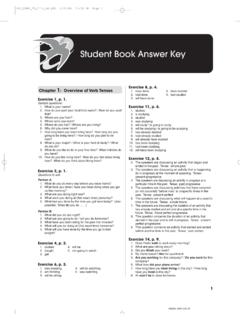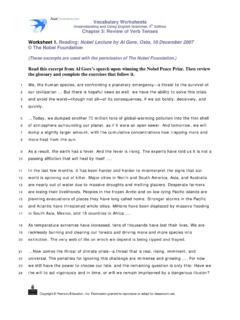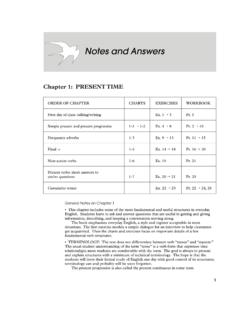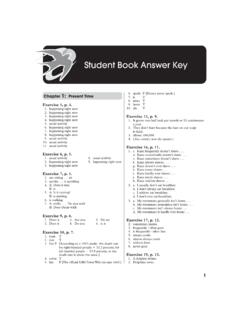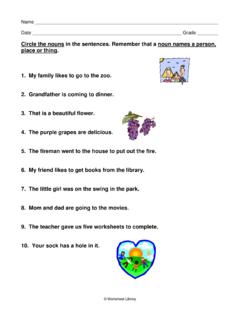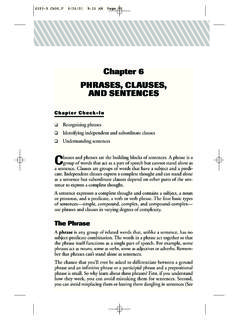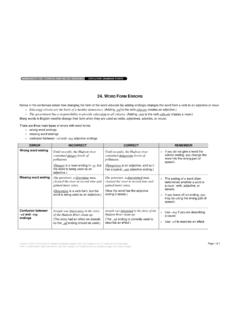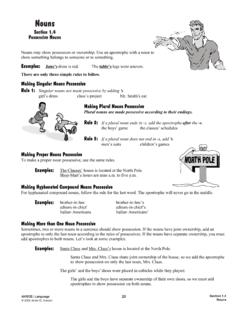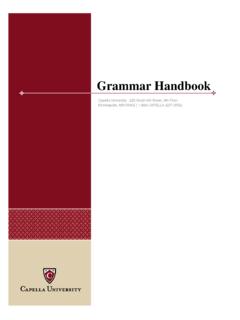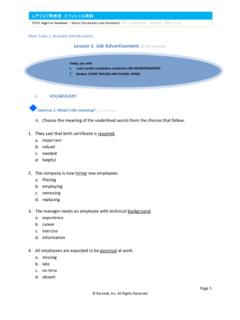Transcription of Chapter 6: NOUNS AND PRONOUNS - AzarGrammar.com
1 72 Chapter 6, NOUNS and PronounsChapter 6: NOUNS AND PRONOUNSORDER OF CHAPTERCHARTSEXERCISESWORKBOOKP reviewEx. 1Pr. 1 Pronunciation of final -s/-es6-1Ex. 2Pr. 2 4 Plural forms of nouns6-2Ex. 3 6 Subjects, verbs, and objects6-3Ex. 5 of prepositions6-4Ex. 8 9 Prepositions of time6-5Ex. 10 11Pr. 10 Word order: place and time6-6Ex. 12Pr. 11 Subject verb agreement6-7Ex. 13Pr. 12 13 Using adjectives to describe nouns6-8Ex. 14 16Pr. 14 15 Using NOUNS as adjectives6-9Ex. 17 18Pr. 16 Summary review: nounsEx. 19 20Pr. 17 Personal pronouns6-10Ex. 21 22Pr. 18 20 Possessive nouns6-11Ex. 23 24Pr. 21 22 Summary review: NOUNS -s/-esEx. 25 Possessive PRONOUNS and adjectives6-12Ex. 26Pr. 23 24 Reflexive pronouns6-13Ex. 27 30Pr. 25 26 Summary review: pronounsPr. 27 28 Forms of other6-14 6-16Ex. 31 35Pr. 29 32 Cumulative reviewEx.
2 36Pr. 33 3406_ph/prs_AZAR_39601 11/6/02 9:17 AM Page 72 General Notes on Chapter 6 NOUNS are the basic tools for giving names to and talking about things and need usage ability of not only NOUNS but associated words, such as PRONOUNS ,adjectives, and prepositions. The Chapter seeks to provide an acquaintance with these basicstructures and terms in English grammar and how they fit into the fundamental patterns ofthe simple sentence in English. TERMINOLOGY: Some books use the term noun adjunct for the word vegetableinthe phrase vegetable garden,but this text simply calls it a noun used as an adjective. Adistinction is made between possessive PRONOUNS ( ,my)and possessive adjectives ( ,mine). EXERCISE 1, p. 156. Preview: grammar terms. ( Chapter 6)This exercise depends upon the teacher to supply an introductory understanding of theconcepts these grammar terms represent.
3 Some students will be quite familiar with theseterms, and some students will not be, in which case this exercise should catch theirattention as to what they need to learn in this you discuss Exercise 1, you might use the following item 1:shirtis a thing. The traditional definition of a noun as a person, place, orthing can be useful to students. A noun can also be defined as a word that functions as asubject or object in a sentence. In this item,shirtis grammatically the object of the verbwearin the basic structure of a simple sentence:subject verb object.(See Charts 6-3and 6-4 for explanations of subjects and objects.)Item 2:inis a little word called a preposition. Prepositions are usually placed in frontof NOUNS (or PRONOUNS ) and give information about place, time, and other the students how many prepositions they can name (without looking at Chart 6-4).
4 Item 3: a pronoun refers to, and has the same meaning as, a Stevearethe same person in this 4: an adjective describes ( , adds information about) a noun or pronoun;thirstydescribes the subject you say Ali is thirsty,then thirstydescribes Ali.(Note: Somelanguages do not require a verb in this kind of statement, but English requires be.)This preview contains basic simple sentences. If your students want to analyze them,they will find: All three patterns with main verb be:be prepositional phrase of place(items 2, 3, and 13)be adjective(item 4)be noun phrase(items 11 and 12) Beas auxiliary verb (item 3, second verb) Basic S V O in items 1, 5, 6, 9, 10, 14, 15 Basic S V (intransitive verb) in items 7 and 8 EXPANSION:Knowing some of the basic grammar terminology presented in thischapter will help students use dictionaries more effectively, where words are identified asnouns, PRONOUNS , prepositions, adjectives, etc.
5 Perhaps at the conclusion of this exercise, orat some later point in this unit, students could investigate in their own dictionaries whereand how these grammar terms are and Answers7306_ph/prs_AZAR_39601 11/6/02 9:17 AM Page 73 EXERCISE 2, p. 157. Pronunciation of final -S/-ES. (Chart 6 -1)Clarify the information in Chart 6-1 by identifying voiced and voiceless sounds. Forexample, point out that final -sis pronounced /z/ in item 1 because /m/ is a voiced soundand pronounced /s/ in item 2 because /k/ is a voiceless z/ EXERCISE 3, p. 157. Preview: plural NOUNS . (Chart 6 -2)This preview exercise is intended to call students attention to singular and plural using this text are already familiar with much of the grammar in this exercise, butsome of the grammar is probably new to them ( , the use of the word offspring ).
6 EXPANSION:This practice can also be used in class discussion to identify the basicstructures of the simple V O in items 1, 2, 3, 5, 7, 8, 9, 10S V PrepPhr (of place) in item 4S be noun in items 6 and 10 six citieshave many in hot, humid t have offspringof bookson several active have large headsand sharp eat leaves,roots,insects,and 6, NOUNS and PronounsCHART 6-1: PRONUNCIATION OF FINAL -S/-ES Final -s/-esis troublesome for all ESL/EFL students. Paying special attention to itspronunciations can be helpful. In a way, students need to train themselves to be aware of hearing-s/-esas an aid to using it correctly in their own production, both spoken and written. Explain and model the pronunciation of the examples. To explain voiceless vs. voiced, tell the students to put their hand to their voice box to feelvibrations.
7 A voiceless sound such as /t/ or /s/ comes from air being pushed through the tongueand teeth; a voiced sound such as /d/ or /z/ emanates from the voice box. Point out that in voiceless-voiced pairs such as /s/ and /z/, the tongue and teeth are in the sameposition. The only difference is the addition of the voice box to the /z/ sound. Some other voiceless vs. voiced pairs are /t/ and /d/, /p/ and /b/, /f/ and /v/. Define buzz (the sound a bee makes). The upside down e in the symbol / z/ is called a schwa. 06_ph/prs_AZAR_39601 11/6/02 9:17 AM Page 74 EXERCISE 4, p. 159. Plural NOUNS . (Chart 6 - 2) and Answers75 CHART 6-2: PLURAL FORMS OF NOUNS You may wish to model the NOUNS in (a) to illustrate the three different pronunciations of final-s/-es: birds bird /z/; streets street /s/;and roses rose / z/. In section (f ), you may point out that -s,not -es,is added to NOUNS that end in -owhen thenoun is a shortened form ( ,autoinstead of automobile),when the noun is related to a musicalterm, and when the noun ends in two vowels.
8 Or you can simply say that sometimes one adds -sand sometimes -es;when in doubt, look it up. Section (i) is included simply to inform the students that some oddities in the formation ofplural NOUNS do exist. Words with foreign plurals are not emphasized in this text; they are dealtwith more fully in Understanding and Using English four words in section (i) aredifficult vocabulary for most students at this level. They will encounter the word phenomenaagain in Chapter 11 in the discussion of phenomena of nature that are used as noncount NOUNS .(You might want to note that these rather unusual NOUNS are in the process of being Anglicized;that is, they are often spoken with more regular forms: , one bacteria, two cactuses, onephenomena. In formal writing, however, the forms in this chart are still preferred.)CHART 6-3: SUBJECTS, VERBS, AND OBJECTS This is, of course, a simplified explanation of the simple sentence, but the students need only abasic understanding of subjects, verbs, and objects.
9 You may want to delay a discussion of intransitive vs. transitive verbs until Chapter 10, wherethe distinction is dealt with in connection with the passive form. If you decide to introduce theterminology here, you could point out that dictionaries might label intransitive verbs as Vor Iand transitive verbs as V Oor 11/6/02 9:17 AM Page 75 EXERCISE 5, p. 160. Subjects, verbs, and objects. (Chart 6 - 3)This is a simple exercise, but the grammar it demonstrates is essential for students of thistext to dogchasedthe roommate openedthe watching her sister s children. EXERCISE 6, p. 160. NOUNS and verbs. (Charts 6 - 2 and 6 - 3)You might want to discuss the sentence structure of some of these items. Ask the studentshow they know the italicized word is a noun or a EXERCISE 7, p. 161. NOUNS and verbs. (Charts 6 - 2 and 6 - 3)This practice requires a good understanding of the fundamental structure of the simplesentence and the grammatical functions of NOUNS and verbs.
10 Students who are unable tocomplete it successfully may need extra help before they proceed in the Chapter . Studentswho can t identify NOUNS and verbs will be at a great disadvantage throughout the rest of :We walked home in the :It :Paintcan be very :I will paintmy bedroom this :I wore the tieyou bought :I tieda string around the :The phonekept ringing last night, but I didn t get out of bed to answer :I ll phoneyou in the morning.(an informal use) :I bought my dress at a little shopin Los :We shoppedfor :His facewas familiar, but I couldn t remember his :I can t facemy boss after the terrible mistake I made at :We couldn t drink the waterbecause the stream was :I wateredthe vegetable garden this :My sister drew a circlearound the correct :I will circlethe correct answer to that :There s a flyon the :I m going to flyto Rome next 6, NOUNS and Pronouns06_ph/prs_AZAR_39601 11/6/02 9:17 AM Page 76 EXERCISE 8, p.

